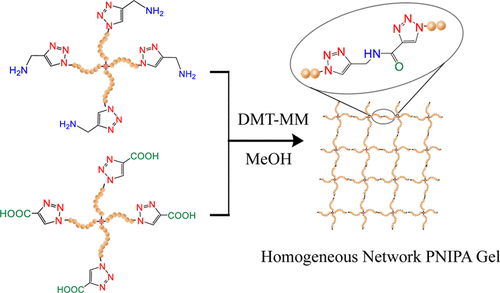当前位置:
X-MOL 学术
›
Macromolecules
›
论文详情
Our official English website, www.x-mol.net, welcomes your
feedback! (Note: you will need to create a separate account there.)
Precise Synthesis of a Homogeneous Thermoresponsive Polymer Network Composed of Four-Branched Star Polymers with a Narrow Molecular Weight Distribution
Macromolecules ( IF 5.1 ) Pub Date : 2019-12-26 , DOI: 10.1021/acs.macromol.9b01616 Yuumi Okaya 1 , Yuto Jochi 1 , Takahiro Seki 1 , Kotaro Satoh 1 , Masami Kamigaito 1 , Taiki Hoshino 2 , Tomotaka Nakatani 2 , So Fujinami 2 , Masaki Takata 3 , Yukikazu Takeoka 1
Macromolecules ( IF 5.1 ) Pub Date : 2019-12-26 , DOI: 10.1021/acs.macromol.9b01616 Yuumi Okaya 1 , Yuto Jochi 1 , Takahiro Seki 1 , Kotaro Satoh 1 , Masami Kamigaito 1 , Taiki Hoshino 2 , Tomotaka Nakatani 2 , So Fujinami 2 , Masaki Takata 3 , Yukikazu Takeoka 1
Affiliation

|
In this study, the synthesis of a star-shaped polymer with a narrow molecular weight distribution and subsequent formation of a homogeneous polymer network composed of the star-shaped polymer were realized by combining single-electron transfer living radical polymerization, click reaction, and amide bond formation with a condensing agent, which are toolized reactions. First, a 4-armed star polymer consisting of N-isopropylacrylamide was synthesized by living radical polymerization using N,N′-ethylenebis (2,2-dichloroacetamide) as a 4-branched initiator. By this polymerization method, a terminal Cl 4-branched star poly(N-isopropylacrylamide) (PNIPA) with a narrow molecular weight distribution could be obtained, but it was found that the reaction activity of the polymer terminal was lost in the process of purification and isolation. Therefore, after obtaining the terminal Cl 4-branched star PNIPA by living radical polymerization, an azide reaction was carried out in one pot without purification and isolation of the star-shaped polymer. As a result, the azide group was successfully introduced to all ends of the star-shaped polymer. By introducing a carboxyl group or an amino group into the 4-branched star polymer with azide groups using a click reaction, two types of 4-branched star polymers with different end groups were obtained. Equal amounts of both 4-branched star polymers were mixed at a polymer concentration equal to or higher than the overlapping concentration, and as a result of forming an amide bond with a condensing agent, a polymer gel was obtained. The swelling behaviors of the polymer gel indicate that almost no unreacted carboxyl group or amino group was present in the obtained polymer gel. That is, it was found that both 4-branched star polymers reacted efficiently to form a polymer network. In addition, structural observation of the polymer network by the small-angle X-ray scattering method showed that a polymer gel consisting of a network of uniform size was obtained. As mentioned above, we succeeded in constructing a polymer gel consisting of a homogeneous network structure using a temperature-responsive 4-branched star polymer as the building block. The living radical polymerization method, the click reaction, and the amide formation by condensation reaction used in this study can be applied not only to the NIPA used here but also to various other monomers. If the construction of a precise network structure is realized by many polymers and the relation with the functional expression derived from the structure is clarified, it will be possible to design the network structure in accordance with the usage of the polymer gel.
中文翻译:

均相热响应聚合物网络的精确合成,该网络由分子量分布较窄的四支星形聚合物组成
在这项研究中,通过结合单电子转移活性自由基聚合,点击反应和酰胺,实现了窄分子量分布的星形聚合物的合成以及随后形成的由星形聚合物组成的均相聚合物网络。与缩合剂形成键,这是工具化反应。首先,使用N,N′-亚乙基双(2,2-二氯乙酰胺)作为4-支链引发剂,通过活性自由基聚合来合成由N-异丙基丙烯酰胺组成的4-臂星形聚合物。通过该聚合方法,末端Cl 4支链星形聚(N可以得到分子量分布窄的β-异丙基丙烯酰胺)(PNIPA),但是发现在纯化和分离过程中聚合物末端的反应活性降低了。因此,在通过活性自由基聚合获得末端Cl 4-支化星形PNIPA之后,在不纯化和分离星形聚合物的情况下在一个罐中进行叠氮化物反应。结果,叠氮化物基团成功地引入到星形聚合物的所有末端。通过利用点击反应将羧基或氨基引入具有叠氮化物基团的4-支星形聚合物中,获得了具有不同端基的两种类型的4-支星形聚合物。以等于或高于重叠浓度的聚合物浓度混合等量的两种4-支星形聚合物,并且作为与缩合剂形成酰胺键的结果,获得了聚合物凝胶。聚合物凝胶的溶胀行为表明,在获得的聚合物凝胶中几乎不存在未反应的羧基或氨基。即,发现两种4-支星形聚合物有效地反应形成聚合物网络。另外,通过小角X射线散射法对聚合物网络的结构观察表明,获得了由均一尺寸的网络组成的聚合物凝胶。如上所述,我们成功地使用温度敏感的4支星形聚合物作为结构单元,构建了由均质网络结构组成的聚合物凝胶。本研究中使用的活性自由基聚合方法,点击反应和通过缩合反应生成酰胺的方法不仅可以应用于此处使用的NIPA,而且还可以应用于各种其他单体。如果通过许多聚合物实现精确的网络结构的构建,并且阐明了与衍生自该结构的功能性表达的关系,则可以根据聚合物凝胶的用途来设计网络结构。
更新日期:2019-12-27
中文翻译:

均相热响应聚合物网络的精确合成,该网络由分子量分布较窄的四支星形聚合物组成
在这项研究中,通过结合单电子转移活性自由基聚合,点击反应和酰胺,实现了窄分子量分布的星形聚合物的合成以及随后形成的由星形聚合物组成的均相聚合物网络。与缩合剂形成键,这是工具化反应。首先,使用N,N′-亚乙基双(2,2-二氯乙酰胺)作为4-支链引发剂,通过活性自由基聚合来合成由N-异丙基丙烯酰胺组成的4-臂星形聚合物。通过该聚合方法,末端Cl 4支链星形聚(N可以得到分子量分布窄的β-异丙基丙烯酰胺)(PNIPA),但是发现在纯化和分离过程中聚合物末端的反应活性降低了。因此,在通过活性自由基聚合获得末端Cl 4-支化星形PNIPA之后,在不纯化和分离星形聚合物的情况下在一个罐中进行叠氮化物反应。结果,叠氮化物基团成功地引入到星形聚合物的所有末端。通过利用点击反应将羧基或氨基引入具有叠氮化物基团的4-支星形聚合物中,获得了具有不同端基的两种类型的4-支星形聚合物。以等于或高于重叠浓度的聚合物浓度混合等量的两种4-支星形聚合物,并且作为与缩合剂形成酰胺键的结果,获得了聚合物凝胶。聚合物凝胶的溶胀行为表明,在获得的聚合物凝胶中几乎不存在未反应的羧基或氨基。即,发现两种4-支星形聚合物有效地反应形成聚合物网络。另外,通过小角X射线散射法对聚合物网络的结构观察表明,获得了由均一尺寸的网络组成的聚合物凝胶。如上所述,我们成功地使用温度敏感的4支星形聚合物作为结构单元,构建了由均质网络结构组成的聚合物凝胶。本研究中使用的活性自由基聚合方法,点击反应和通过缩合反应生成酰胺的方法不仅可以应用于此处使用的NIPA,而且还可以应用于各种其他单体。如果通过许多聚合物实现精确的网络结构的构建,并且阐明了与衍生自该结构的功能性表达的关系,则可以根据聚合物凝胶的用途来设计网络结构。











































 京公网安备 11010802027423号
京公网安备 11010802027423号